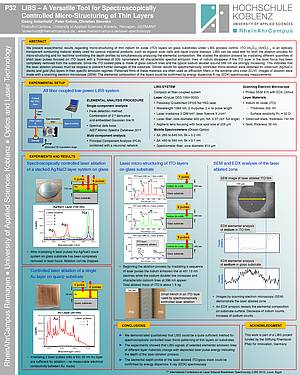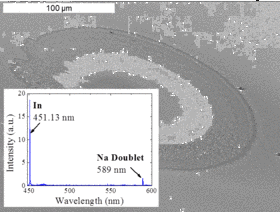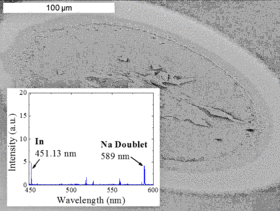Laserinduzierte Plasmaspektroskopie zur spektroskopisch kontrollierten Mikrostrukturierung dünner Schichten
7th International Conference on Laser-Induced
Breakdown Spectroscopy (LIBS 2012),
29 Sept. - 4 Oct. 2012, Luxor, Egypt
In this field of activity we are investigating micro-structuring of thin indium tin oxide (ITO) layers on glass substrates under LIBS process control. ITO (In2O3)x:(SnO2)1-x is an optically transparent conducting material widely used for various industrial products, such as organic solar cells and liquid crystal displays. LIBS can be used well for both the ablation process for micro-structuring and for real-time controlling the depth profiles by simultaneously analyzing the elemental composition. We studied the ablation process by irradiating different quantities of short laser pulses focused on ITO layers with a thickness of 200 nanometers. All characteristic spectral emission lines of indium disappear if the ITO layer in the laser focus has been completely removed from the substrate. Since the ITO coated plate is made of glass calcium lines and the typical sodium doublet around 589 nm are strongly increasing. This indicates that the laser ablation process must be stopped to prevent further damages of the substrate.
Similar results for spectrometrically controlled micro-ablation were obtained for silver/salt (Ag/NaCl) stacks and gold (Au) layers in their specific emission regimes. Patterned films of these materials are often used as diffraction filters in the extreme ultra violet (EUV). Images of ablation were made with a scanning electron microscope (SEM). The elemental composition of the layers could be confirmed by energy dispersive X-ray (EDX) spectroscopy measurements.
Scanning electron microscope (SEM) images of an ITO layer deposited on a glass substrate
after irradiating 1 laser pulse (left) and several laser pulses (right). The regarded LIBS spectra
show a decrease of the indium (In) line and an increase of the sodium (Na) doublet as the number
of laser pulses increases.








